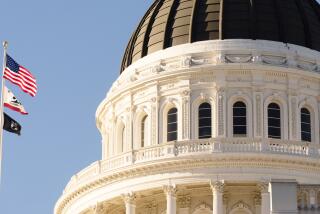UCLA Analysts Read Numbers Differently, See Recession in ’88
- Share via
On a day many analysts were heartened by signs that the economy might shrug off October’s stock market crash after all, UCLA analysts nonetheless said Wednesday that the United States already has entered a recession that will last into next year.
“I feel like I’m living on a different planet,” said Larry J. Kimbell, director of UCLA’s business forecasting project. “Other people look at the same numbers and are cheerful.”
In their annual report on the national and state economies, UCLA researchers said the U.S. economy, unnerved by the stock market crash, will shrink next year by 1%. They said the downturn will be sharp but short, not lasting beyond June. “You might say the pink slips are written--but they’re not yet in the mail,” Kimbell said of companies’ plans to cut employment.
The report, which noted that Federal Reserve policy will play a key role in determining the downturn’s severity, also found that:
- Consumers will be so cautious about spending money that the national savings rate will go up by 1%. The added savings--dollars that otherwise would be spent and therefore help the economy--are the recession’s “trigger,” the researchers found. The spending plunge already in progress will ease next year but still result in a decrease, compared to 1987.
- The recession’s impact in California will be cushioned by a budget surplus of $1.1 billion that state officials are returning to residents. The cash will provide “a timely and significant boost to consumer spending” in California, the report said.
- As might be expected, the recession will be reflected in fewer housing starts and declines in business investment and corporate profits, all of which will bounce back by 1989. In fact, housing will surpass this year’s performance by 1989.
Economists, government officials and business executives agree that the Oct. 19 stock debacle heightened the odds of a recession next year.
In recent days, however, the economy has provided several hints that the downturn might be avoided. On Wednesday, for example, the Commerce Department reported that U.S. firms plan a hefty increase in spending on new plant and equipment. The department also reported a robust 7.5% increase in new home construction during November.
These encouraging signs came after other recent reports that employment and industrial production rose sharply in November. Kimbell, in explaining his pessimistic views, cited the more ambiguous finding of a 0.2% increase in retail sales in November, a lackluster showing that followed an actual drop in October. A dismal fourth quarter for retailers, including the Christmas season, “is already in the refrigerator,” he maintained.
As they try to fathom the economy’s prospects, many analysts are looking closely at the Federal Reserve, which has presided over an extraordinary drop in the money supply this year, interrupted only temporarily after the stock plunge.
The UCLA researchers said Wednesday that they expect a quick reversal in Fed policy as soon as the signs of recession become more obvious.
In keeping with their views of slow economic activity, UCLA’s economists project modest inflation next year. According to Daniel J. B. Mitchell, director of the university’s Institute of Industrial Relations, prices will rise in the range of 3.5% to 4%, a level consistent with that of the past few years--if such volatile elements as oil and food are not considered. Despite some inflation that results from the weaker dollar, “None of this seems to be turning into a wage-price spiral,” he said.
“It takes awhile for the numbers to show up. People sort of expect the turnaround to come instantaneously--but it doesn’t.”
More to Read
Inside the business of entertainment
The Wide Shot brings you news, analysis and insights on everything from streaming wars to production — and what it all means for the future.
You may occasionally receive promotional content from the Los Angeles Times.










